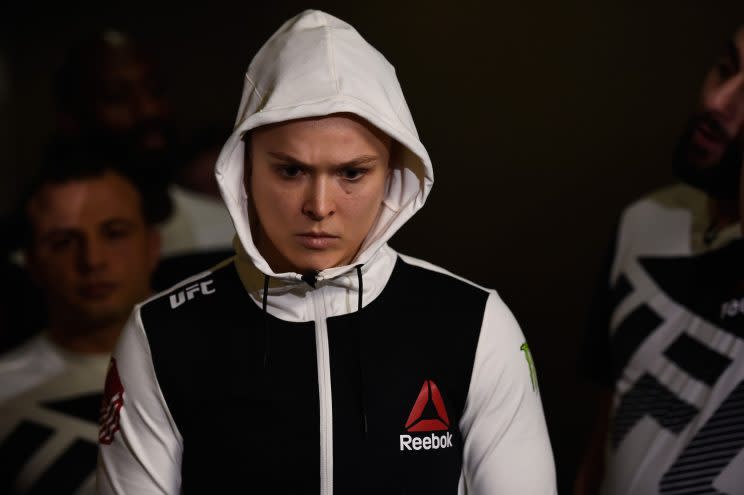Forget the asinine talking heads; Ronda Rousey put women's MMA in position to thrive long after she's gone
You know a topic in the mixed martial arts world is reaching its expiration date when the hot takers arrive on the scene.
Ronda Rousey’s one-sided loss to Amanda Nunes in the main event of UFC 207 on Dec. 30 has been analyzed and dissected from all angles, in a matter befitting the fall of one of the sport’s transcendent stars.
Then along came the yakkers, the ones who come screaming out of your television set and make you seriously consider joining the millions of people across the country who have ditched cable.
Not all that long ago, this cavalcade of clowns was debating how Rousey would fare against boxer Floyd Mayweather. But over the past several days, a crew who couldn’t tell you the difference between a wristlock and a wristwatch suddenly want to tell you that Rousey wasn’t that good in the first place, and that women’s fighting was some sort of mirage hustled by hucksters on an unassuming public.
But those who follow the sport on a week-in, week-out basis and don’t just parachute onto the scene when MMA website clicks go through the roof, understand that even if Rousey vanishes from the scene forever, not only did she leave with her legacy secure, but she does so with the entirety of women’s MMA in a healthy space.

To understand why, you need only look at the case of the founding of the UFC and its first star, Royce Gracie.
Gracie is remembered, correctly, as one of the pioneering figures in the history of combat sports. His run at the UFC’s outset in the mid-1990s changed people’s perceptions of fighting. In a world conditioned to action movie stars and larger-than-life badasses, an average-sized guy used jiu-jitsu to fluster everyone from larger fighters to boxers to karate practitioners.
But while he’s remembered for his dominance, Gracie’s prime came and went in the blink of an eye.
His final victory in the UFC, a submission win over Dan Severn at UFC 4, was a mere 13 months after his tournament victory at UFC 1. He fought Ken Shamrock to a draw at UFC 5, the first UFC fight ever conducted with a time limit, and then disappeared from fighting for several years.
Rules changes were used as a cover reason for why Gracie left, but the simple reality is that the wild success of the early UFC brought in the next generation of fighters – often champion amateur wrestlers who had long lacked an outlet to make money in legitimate professional competition – who were more skilled than the previous generation. Gracie used a unique skill to create something out of nothing, then left something which eventually grew bigger than anything he could have imagined.
This cycle of increasing talent has repeated endlessly, with Gracie, Severn and Shamrock giving way to Mark Coleman and Frank Shamrock; and them giving way to Tito Ortiz and Chuck Liddell; and to Georges St-Pierre and Anderson Silva, up to today’s stars. The trailblazing Gracie breezed through his first 10 or so fights, then ran into a wall as the competition got better and more well-rounded. Sound familiar?
Rousey’s skill that put her ahead of the pack was her judo, which was feared and avoided. That was good enough to propel her over the legendarily tough Miesha Tate, former world champion Sarah Kaufman, Olympic wrestling silver medalist Sarah McMann, former Marine Corps sergeant Liz Carmouche, and so on.
But while Rousey continued to rely on her judo skills, and closed herself off to all but her inner circle as her fame grew, the next generation of female competitors were coming up and making their presence felt at the sport’s elite gyms.
Rousey finally got caught by one of those fighters, JacksonWink’s Holly Holm, at UFC 193, then vanished for a year.
And the sport thrived in her absence.
It’s true that another woman hasn’t yet emerged to match Rousey’s pay-per-view drawing power, though such transcendent figures only come around a couple times per generation, regardless of gender. But television numbers have proven women’s fighting to be a reliable, consistent draw.
Cris “Cyborg” Justino’s matchup with the unheralded Lina Lansberg in September drew 1.326 million viewers, FS1’s best MMA number of the fall. Strawweight champ Joanna Jedrzejczyk’s win over Claudia Gadelha on FS1 cracked a million viewers in the dog days of summer in mid-July. The most recent FOX network television card in Sacramento was headlined by Michelle Waterson’s first-round finish of Paige VanZant and drew the company’s best FOX number in three years, with a staggering 4.8 million viewers tuning in for the main event.
New UFC owners WME bought the company for $4.2 billion in large part because of the expectation they’ll make a big score on the UFC’s next television contracts, set to come up in 2018. The elusive pay-per-view needle movers are still the most important cog in the machine, but fighters who can draw television ratings are more important than ever, and viewers continuously prove they’ll flock to a solid women’s bout.
It’s highly unlikely Rousey will ever gain her previous dominance in the cage. But she entered the UFC in 2013 with detractors insisting no one would pay to see women fight. She leaves with women’s mixed martial arts an integral part of a multibillion-dollar brand.
That can never be taken from Rousey no matter how much TV trash talkers try to claim otherwise.


